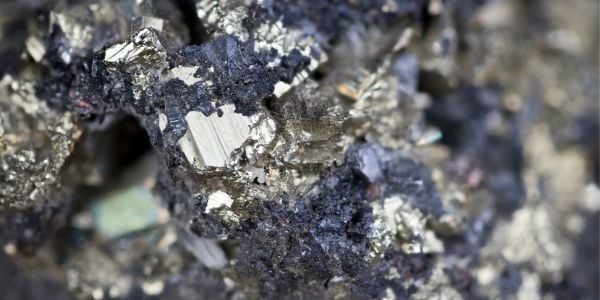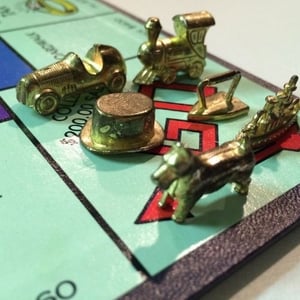
Zinc is an essential trace element that has many important functions in the body, for both humans and animals.
However, if there is going to be a case of too much of a good thing, then this is it.
Zinc toxicosis is very dangerous and can occur very easily in pets.
Overexposure can happen when a dog or cat consumes too much of something containing zinc, or one item that contains a high level of zinc, such as a US-minted penny (read more about that below).
Common Items That Contain Zinc
- zinc oxide creams – for psoriasis, diaper rash, sunscreen, etc.
- the coating on certain cookware
- batteries
- paint
- screws, nuts, and bolts
- human supplements and vitamins
- zipper pulls
 Even some board game pieces! As shared on Reddit, an emergency veterinarian took an x-ray of a sick patient that revealed a zinc-containing monopoly piece.
Even some board game pieces! As shared on Reddit, an emergency veterinarian took an x-ray of a sick patient that revealed a zinc-containing monopoly piece.
The x-ray revealed not just any piece – it was the monopoly dog of all pieces in the patient's stomach contributing to the symptoms and illness!
Luckily, they were able to retrieve the offending "Scottish terrier," game piece, and the patient went on to recover after spending a night in the ICU.
Some human foods like oysters, almonds, and chickpeas contain zinc.
These likely won’t cause zinc toxicity in your dogs or cats unless they consume these foods in extremely high quantities, such as several pounds of these foods at a time, or consume these foods daily for months, which neither is recommended.
The $1,000 Penny
Perhaps one of the most well-known sources of zinc toxicity in veterinary medicine and pets is the ingestion of the USA Lincoln-Penny minted after 1982, which are 97.5% zinc by weight or ~2,440mg of elemental zinc per coin!
So nearly 100% of the coin is made of zinc! For example, it is recommended that humans only take a total of 15mg of elemental zinc (not total zinc) per DAY of zinc for normal function!
Zinc toxicity can cause significant health consequences in your pet if ingested in considerable amounts.
Check out this CBS News story of a Mastiff pup that thought she was a piggy bank, eating 113 pennies!
How Much Zinc is Toxic to Your Pet?
It depends on how much and what form of zinc was ingested, as well as the size of your pet.
Specific types of zinc-containing products, such as some creams, are more easily absorbed by the gastrointestinal tract than others, meaning that they could cause symptoms sooner than perhaps a zinc-containing metal object, but may only cause mild symptoms, such as a mild stomach upset.
However, if your pet ingested even a single penny minted after 1982, this ingestion can be life-threatening due to the high amount of zinc contained within the penny itself.

That being said, if your pet was to ingest an entire tube of zinc-containing cream or ingest this cream repeatedly over time, this could also be very dangerous.
Therefore, as with any ingestion of a toxic substance, it is always recommended that you call your veterinarian or a pet poison helpline if you’re ever concerned.
Symptoms of Zinc Toxicity in Pets
Symptoms may vary depending on the amount ingested as well as the form ingested, and the size of your pet.
However, classic symptoms may include:
- Vomiting
- Not eating or decreased appetite
- Lack of energy
- Diarrhea
- Pale or yellow gums (jaundice)
- Orange-tinged feces or urine
- Yellowing of the skin and eye
Depending on the type of zinc consumed and how much, symptoms can develop within a few hours to days.
If zinc poisoning is left undetected and untreated, it can cause death or life-threatening:
- Anemia
- Seizures
- Kidney and/or liver damage
- Heart issues
Why You Shouldn’t Let Your Dog or Cat Lick Your Sunscreen
Even though it’s hard to resist those canine and kitty kisses, be careful in the summer, especially after applying your 50+ sunscreen. In case you didn’t know already, one of the main ingredients in your sunscreen is zinc and, if your pet were to lick this off, especially repetitively, this could make them sick.
Typically, ointments such as sunscreen cause mild gastrointestinal signs such as nausea and vomiting or diarrhea.
How is Zinc Toxicity Diagnosed?
Diagnosis is based on the history you provide of any ingestion of zinc-containing products as well as a complete physical examination.
These may provide clues that the patient is suffering from zinc toxicosis. It’s always an excellent idea to bring any packaging, tubing, or taking a photo of the product that your pet ate (even vomited back up) or chewed on to help provide this information to your veterinarian!
Additionally, diagnostics such as blood tests may reveal elevated zinc concentrations, anemia (low red blood cell), liver or kidney damage, or a urinalysis may indicate hemoglobinuria (red blood cell pigment in the urine that shouldn’t be there) or other evidence of kidney damage.
These, together with radiographs (x-rays), should identify if a zinc-containing metal object is present.
Treating Zinc Toxicosis in Pets
Treating your pet for this toxicity will depend on the product and amount ingested and the severity of your pet’s condition.
Your pet may need to be hospitalized and stabilized with intravenous fluids and medication to control vomiting and stomach upset may be required.
Or, if they have an object in their stomach or intestines, they may need to go under anesthesia for the immediate retrieval of the object via endoscopy or (more rarely) exploratory surgery as time is of the essence.
However, a patient must be stable before either of these procedures can be undertaken. Blood transfusions are occasionally required to treat anemia as well as medications to protect their gastrointestinal tract, liver, and kidneys.
The cost for treatment could be in several hundred to thousands of dollars, depending on what zinc-containing product was consumed.
Outcomes After Zinc Toxicosis
Your pet’s outcome will depend on these factors:- When the symptoms were first noticed
- What product and how much was ingested
- When you first took your pet to the veterinarian and when treatment was able to be started
- How well your pet responds to treatment
As always, if you suspect your pet ingested something toxic, call your veterinarian or a pet poison control line, immediately.
Do not attempt to make your pet vomit at home or to take care of the issue yourself as you could do more harm than help.



